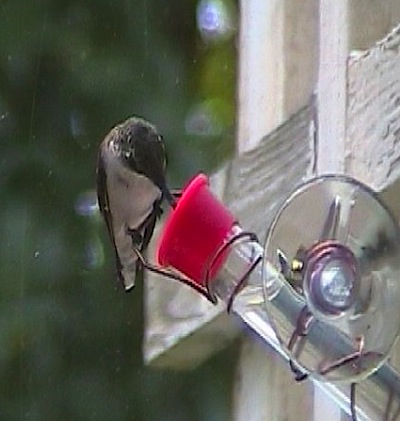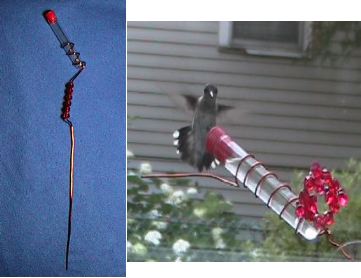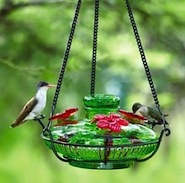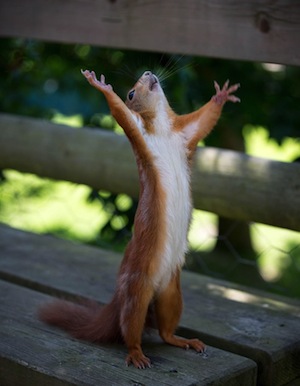-
window hummingbird feeder trains sprites for hand feeding!
Sometimes it’s the tiniest things that can bear the biggest impact. Hummingbirds for example, are the smallest of beaked migratory visitors, but their performances are anything but small in stature! Putting on some of the greatest shows with their expert acrobatics and natural antics, it’s no wonder these tiny sprites continue to mesmerize and endear so many people.
Not too terribly shy either, once they become regulars at backyard fountains or feeders, and familiar with their hosts… they’ll buzz by so close you can feel the breeze from their speedy wings! It happened just today… while changing nectar in the window hummingbird feeder – her swift movement caused a swooshing breeze and a bass-like buzz that went right by my head… it made for a pretty magical experience!
Oh, and the tiny tube feeder on the window? It’s actually part of set that lets you train hummingbirds to eat from your hand (well almost). The idea is once they get used to the tubes, you sit quietly holding the feeder by the copper wand and the sprites come right up and eat – within twelve or so inches from you. One feeder is staked to set in a flower pot or plant, the other a window feeder. It’s actually pretty cool, but does require a little bit of patience. Training time may vary depending on how well your hummingbirds know you.
A tiny little feeder set for some tiny birds that promise to bring some big amazement to your world!
-
Hummingbird Feeders and Audubon’s Newest Citizen Science Project
A recent discussion on the absence of usual numbers of tiny sprites at nectar feeders concluded with several possible scenarios. So today when this email (and plea for help with a new citizen science project) from Audubon was opened… we thought it quite pertinent to what was recently concluded on the declining numbers of these magical birds at backyard hummingbird feeders.
From Audubon:
A Rufous Hummingbird weighs less than a french fry and can fly 1,000 miles without food or rest. They may be mighty mites, but there’s one challenge they may not be able to overcome: us.National Audubon Society scientists estimate that the global population of these amazing flyers has declined nearly 60 percent in the past three decades.
What’s pushing hummingbirds toward the brink? A deadly combination of habitat destruction, toxic pollution and the spread of invasive plants. And now a new threat may overshadow them all: ecological chaos caused by a warming climate. Warmer weather prompts earlier flowering of nectar-bearing plants that hummingbirds rely on during their epic migrations. If the flowers are gone before the birds arrive, they may starve.The Rufous Hummingbird was common when we were kids. But it’s just one of dozens of familiar bird species headed for trouble.
Audubon has always been at the forefront of protecting birds and their habitats. And as threats have grown, so have the breadth and sophistication of our conservation strategies.
Hummingbirds at Home
This spring, Audubon united cyberspace with a century of citizen science experience to launch a high-tech tracking project called Hummingbirds at Home. Participants can download a mobile app or access a website to report sightings of hummingbirds nationwide. Using the data, our scientists will map conservation strategies to protect these birds’ future.Hummingbirds at Home is just one of the 21st Century approaches we are taking to secure a future for birds and their habitat. We’re also using Big Data analytics to find hidden patterns in a century of Christmas Bird Count stats. We’re using social media to organize and rally support for bird-friendly laws. And we’re using the web to foster a new generation of bird-lovers who will carry on our conservation work.
Will our children and grandchildren grow up with the wonder of watching a hummingbird hover over the flowerbed or sip nectar from a backyard feeder?
With your help, they will. Please donate today and your gift will go twice as far to protect birds.
Help us save hummingbirds, other birds and their habitats with a generous summer donation to Audubon. And, from now until July 25, your donation will be matched dollar for dollar, up to a total of $200,000! -
first sprite spotted today at the window hummingbird feeder
I think he’s celebrating, hallelujah… spring has sprung!
The very first hummingbird was spotted today, bringing sheer delight in knowing they’re back. For the next six to seven months, sights and sounds around the yard will be a-brimming with silly antics and buzzing activity from these favorite migratory birds. Their very own Pop’s Hummingbird Swing was installed last season and it proved to be a huge hit, so we’ll likely add another this year.
Although feeders are out, there aren’t any flowers yet from which to draw nectar, and that part’s kinda sad. Nothing’s been done in the yard as far as clean-up and planting colorful annuals for the season.
Perennials have not started blooming except for the very early – and long gone crocus and jonquils. Some white candy tuft clumps perch upright in a barren looking landscape, while trees are just sprouting tender green foliage. Leaf misters (that never made it to storage last year) sit ready to spray, and the popular Hummer Helper nesting material is also ready for action!
Because this one hangs from a sturdy window bracket, it serves as our window hummingbird feeder, and eyes are peeled when in the kitchen.
So nice having a feeder right at the window again… and one that squirrels won’t bother with!





